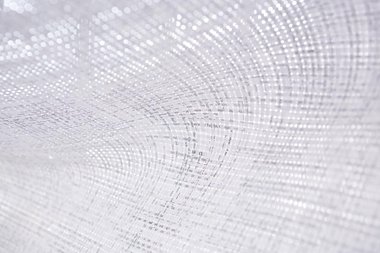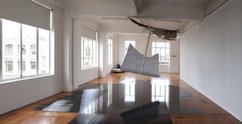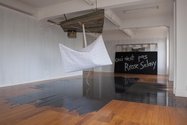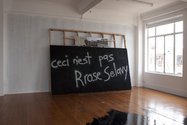John Hurrell – 8 November, 2009
Art about art, by any other name, and a refutation of the history of modern art as conceived and presented as a chronological progression of enshrined stylistic innovations. That kind of deterministic and axiomatic teleology has no place in this show.
Christchurch
A great Place For boats Except in SW Winds
XXXXX XXXXXXXX
21 October - 15 November 2009
The exhibition A Great Place for Boats Except in SW Winds at The Physics Room presents itself as an obscuratan enigma – the artist’s name is blacked out, but given the quasi-Beuysian use of asphalt, various Duchamp references, and the use of woven video tape leads me to confidently attribute the exhibition to Christchurch artist Scott Flanagan, who seems to be placing himself in the bloodline of Dada and Surrealism.
A Great Place consists of three separate installations that echo each other in the found/improvised nature and general poverty of their materials, and the autodidactically emphatic philosophical themes. The premise is straightforward enough: a self-referential meditation on the semiotics of communicating ideas. Art about art, by any other name, and a refutation of the history of modern art as conceived and presented as a chronological progression of enshrined stylistic innovations. That kind of deterministic and axiomatic teleology has no place in this show.
The smallest of these is The Uncarved Philosopher – a full black polythene rubbish bag (presumably filled with rubbish) perched on an ad hoc plinth of wood and chipboard discards. This is perhaps the least successful work, being that it is the bluntest and Flanagan is usually more subtle and thoughtful. It is uncertain whether this is meant to suggest that “all philosophy is bunk”, or the truth that philosophers from Plato to Heidegger carry some very unpleasant political baggage. It is, however, possible that this is some sort of parody of the earnestness of the European avant-garde of the early twentieth century – such groan-inducing puns were fairly typical of Dada. Indeed, the overall effect of the exhibition is as an individualised mend-and-make-do No. 8 wire variation on Kurt Schwitters’ Merzbau.
Codex is the large installation in the centre of the gallery space, an inverted raft (an Antipodean reference perchance?) constructed from refuse and suspended from the ceiling. The sail is woven from shredded texts and an ocean of sorts is alluded to by the complex woven grid of glossy black video tape stuck down to the gallery floor (rumoured to be old VHS porno) with pragmatic sticky tape – the resulting interference patterns give the impression of a crossword puzzle (a motif Flanagan used very successfully in works from earlier in the decade). Clearly this random information, rendered in inaccessible but suggestively ordered formats, has a symbolic value in the work. A codex is a primer key for ordering information, so perhaps this raft represents the fallibility of any attempt to apply order to apparently random and arbitrary information – but that is purely speculation on my part.
Against the far wall rests the third component work The Sign Laid Bare by its Logic, Even. The title is an obvious reference to Marcel Duchamp’s The Bride Stripped Bare By Her Bachelors (the “Large Glass”. The work consists of a large, deliciously tactile asphalt surface supported on a wooden armature. At the top of this structure is a photographic triptych depicting a book open on a passage about Colin McCahon, a demolition site – perhaps whence some of the materials used in these works were sourced, and some abandoned rail tracks. Scrawled across the asphalt like graffiti are the words “Ceci n’est pas Rrose Sélavy”. This is obviously an allusion to the Belgian Surrealist René Magritte’s painting La trahison des images (1928/9) – ‘the treachery of images’, depicting a tobacco pipe with the inscription “Ceci n’est pas une pipe”, ‘this is not a pipe’. It wasn’t a pipe, but a naturalistic painting of a pipe – an image, and The Sign Laid Bare is clearly not Rrose Sélavy or by Rrose Sélavy.
Rrose Sélavy was a drag persona adopted by Marcel Duchamp (it sounds like “Eros, c’est la vie” or ‘Eros, such is life’ in French, get it? Or possibly even “arroser la vie” –‘to make a toast to life’) in 1921, a pseudonym under which he constructed several assemblages. Flanagan (assuming of course that he is the artist) similarly has, in the past, adopted personae to work under (their names being anagrams of his own), and would appear to be constructing a genealogy for his own assemblages with Duchamp as an ancestor. And Magritte as well, for that matter, though more in terms of the Belgian’s impeccable semiotic logic rather than his style or medium. The juxtaposition strikes me as deliberately sophomoric.
It is quite possible that these allusions are simply pegs to hang the formal elements from, and that I am reading far too much into the references. On one level the Chinese Box-like system of allusions, the distancing mechanisms and feints are somewhat frustrating for the viewer – especially as they require a specialization of knowledge that would confound even the expert. At the most basic visual level, this ludic irreverence is irrelevant to appreciating the work in a purely formal way, especially Codex – which is fun and engaging at the immediate visual level – and The Sign Laid Bare – which is very attractive as an assemblage with an innovative use of materials without worrying too much about what it might mean.
Ultimately this is a skillful union of art, avant-garde history, popular culture and quotidian object. While from a future perspective these are unlikely to be among the major works in the artist’s oeuvre, at the same time they are a significant achievement, and suggest the high standards that the artist imposes on himself.
(Thanks to The Physics Room for the above images, and the photographer Mark Gore.




 Two Rooms presents a program of residencies and projects
Two Rooms presents a program of residencies and projects Advertising in this column
Advertising in this column



This Discussion has 0 comments.
Comment
Participate
Register to Participate.
Sign in
Sign in to an existing account.